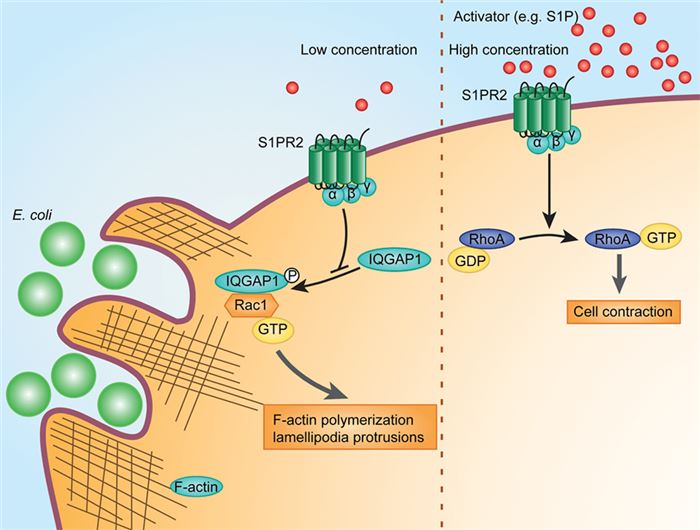Introduction of S1PR2
Sphingosine 1-phoshate 2 (S1PR2) is encoded by the S1PR2 gene. It belongs to the G-protein-coupled receptor (GPCR) family which has been extensively studied during the past few decades because it offers numerous possibilities for therapeutic applications. Sphingosine 1-phosphate (S1P) regulates cell proliferation, apoptosis, motility, and neurite retraction. Edg5 transduced S1P-evoked signaling events relevant to cell proliferation and survival, including activation of the ERK/MAP kinases, and immediate-early induction of c-Jun and c-Fos.
| Basic Information of S1PR2 | |
| Protein Name | Sphingosine 1-phoshate 2 |
| Gene Name | S1PR2, EDG5 |
| Aliases | S1P receptor 2, S1P receptor Edg-5 |
| Organism | Homo sapiens (Human) |
| UniProt ID | O95136 |
| Transmembrane Times | 7 |
| Length (aa) | 353 |
| Sequence |
MGSLYSEYLNPNKVQEHYNYTKETLETQETTSRQVASAFIVILCCAIVVENLLVLIAVARNSKFHSAMYLFL GNLAASDLLAGVAFVANTLLSGSVTLRLTPVQWFAREGSAFITLSASVFSLLAIAIERHVAIAKVKLYGSDK SCRMLLLIGASWLISLVLGGLPILGWNCLGHLEACSTVLPLYAKHYVLCVVTIFSIILLAIVALYVRIYCV VRSSHADMAAPQTLALLKTVTIVLGVFIVCWLPAFSILLLDYACPVHSCPILYKAHYFFAVSTLNSLLNPV IYTWRSRDLRREVLRPLQCWRPGVGVQGRRRGGTPGHHLLPLRSSSSLERGMHMPTSPTFLEGNTVV |
Function of S1PR2 Membrane Protein
S1PR2 is a receptor for the lysosphingolipid S1P. S1P is a bioactive lysophospholipid that elicits diverse physiological effect on most types of cells and tissues. When expressed in rat HTC4 hepatoma cells, it is capable of mediating S1P-induced cell proliferation and suppression of apoptosis. Research has demonstrated that deficiency in S1PR2 enhanced bacterial clearance and promoted survival in the mouse model of sepsis. These beneficial effects are due to an improvement in the phagocytic activity of S1PR2-deficient macrophages. Therefore, interventions targeting S1PR2 signaling may offer a promising therapeutic approach for the prevention and/or treatment of sepsis.
 Fig.1 Proposed mechanism involved in impaired bacterial clearance mediated by S1PR2 signaling in macrophage.
Fig.1 Proposed mechanism involved in impaired bacterial clearance mediated by S1PR2 signaling in macrophage.
Application of S1PR2 Membrane Protein in Literature
This article accounts for, at least in part, S1P-induced cell proliferation, survival, and related signaling events.
This article reveals that Edg-5 communicate not only with G(i) but also with G(q) and G(13). These studies represent the first characterization of S1P receptor activity through G proteins directly and establish fundamental differences in coupling.
This article suggests the possibility of developing therapies against hair cell damage (e.g., from ototoxic drugs) through targeted stimulation of S1PR2.
This article reveals that S1P2R activation in endothelial cells increased vascular permeability. The balance of S1P1 and S1P2 receptors in the endothelium may determine the regulation of vascular permeability by S1P.
Authors in this group characterized the signaling mechanisms involved in the inhibitory action by S1P.
S1PR2 Preparation Options
To obtain the soluble and functional target protein, the versatile Magic™ membrane protein production platform in Creative Biolabs enables many flexible options, from which you can always find a better match for your particular project. Aided by our versatile Magic™ anti-membrane protein antibody discovery platform, we also provide customized anti-S1PR2 antibody development services.
As a forward-looking research institute as well as a leading customer service provider in the field of membrane protein, Creative Biolabs has won good reputation among our worldwide customers for successfully accomplishing numerous challenging projects including generation of many functional membrane proteins. Please feel free to contact us for more information.
All listed services and products are For Research Use Only. Do Not use in any diagnostic or therapeutic applications.